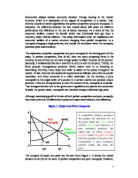Economic Efficiency There are several meanings of the term - but they generally relate to how well an economy allocates scarce resources to meets the needs and wants of consumers. Static Efficiency Static efficiency exists at a point in time and focuses on how much output can be produced now from a given stock of resources and whether producers are charging a price to consumers that fairly reflects the cost of the factors of production used to produce a good or a service. There are two main types of static efficiency, allocative and productive. Allocative Efficiency Allocative efficiency is achieved when the value consumers place on a good or service (reflected in the price they are willing to pay) equals the cost of the resources used up in production. Allocative efficiency occurs when price = marginal cost, when this







